Spatiotemporal Variability of Actual Evapotranspiration and the Dominant Climatic Factors in the Pearl River Basin, China
Abstract
1. Introduction
2. Data and Methods
2.1. Study Area
2.2. Data
2.3. VIC Hydrological Model
2.4. Methodology
2.4.1. Mann–Kendall Trend Test (M–K)
2.4.2. Partial Correlation Analysis
3. Results
3.1. Spatiotemporal Characteristics of ETa
3.1.1. Assessment of the VIC Model Performance
3.1.2. Annual ETa in the PRB
3.1.3. Spatial-Temporal Variation of the ETa
3.2. Relationships between the ETa and Climatic Factors
3.2.1. Partial Correlation Coefficient
3.2.2. Temporal Variation of the Ten Climatic Factors
4. Discussion
4.1. Comparison with Related Studies
4.2. The Dominant Climatic Factor of ETa in the PRB
4.3. Does the “Paradox” Exist When Using ETa Estimation?
5. Conclusions
- (1)
- The analysis of the simulated ETa derived from the VIC model showed that the mean annual ETa of the PRB was 626.1 mm. Additionally, overall, the annual ETa showed a slight but not significant increasing trend in the PRB over the past 55 years, whereas it showed a negative trend during the 1960–1992 period. At the spatial scale, the ETa in the middle and upper stream of the PRB generally exhibited a non-significant decreasing trend, except for some parts which showed a relatively significant decreasing trend. In the downstream areas, especially in the Pearl River Delta and Dongjiang River Basin, the ETa exhibited a significant increasing trend.
- (2)
- According to the analysis of the partial correlation coefficients, the partial correlation coefficients between the ETa and climatic factors varied at different time scales. From 1960 to 1992, the ETa in the PRB had significant correlations with TEMP and VP at the yearly scale. Additionally, it also significantly correlated with SH and PRESS at the monthly scale. From 1992 to 2014, it had a significant correlation with TEMP, SH, and PRESS. In general, after considering the variations of these factors, the changes of the ETa across the PRB were mainly influenced by SH and PRESS.
- (3)
- Overall, mainly due to the decreasing SH, the “paradox” phenomenon existed in the middle-upper area of the PRB during the period of 1960–1992. The phenomenon could be explained by the “global dimming” event in China, resulting from the changes of cloud coverage and aerosol accumulation. The “paradox” phenomenon in the PRB can be detected by ETa estimation, which implies we could also use ETa to further verify the “evaporation paradox”.
Author Contributions
Funding
Acknowledgments
Conflicts of Interest
References
- Falamarzi, Y.; Palizdan, N.; Huang, Y.F.; Lee, T.S. Estimating evapotranspiration from temperature and wind speed data using artificial and wavelet neural networks (WNNs). Agric. Water Manage. 2014, 140, 26–36. [Google Scholar] [CrossRef]
- Fisher, J.; Melton, F.; Middleton, E.; Hain, C.; Anderson, M.; Allen, R.; McCabe, M.; Hook, S.; Baldocchi, D.; Townsend, P.; et al. The future of evapotranspiration: Global requirements for ecosystem functioning, carbon and climate feedbacks, agricultural management, and water resources. Water Resour. Res. 2017, 53, 2618–2626. [Google Scholar] [CrossRef]
- Katul, G.G.; Oren, R.; Manzoni, S.; Higgins, C.; Parlange, M.B. Evapotranspiration: A process driving mass transport and energy exchange in the soil-plant-atmosphere-climate system. Rev. Geophys. 2012, 7. [Google Scholar] [CrossRef]
- Mu, Q.; Zhao, M.; Running, S.W. Improvements to a MODIS global terrestrial evapotranspiration algorithm. Remote Sens. Environ. 2011, 115, 1781–1800. [Google Scholar] [CrossRef]
- Trenberth, K.E.; Fasullo, J.T.; Kiehl, J. Earth’s Global Energy Budget. Bull. Am. Meteorol. Soc. 2009, 90, 311–324. [Google Scholar] [CrossRef]
- Wang, K.; Dickinson, R.E. A review of global terrestrial evapotranspiration: Observation, modeling, climatology, and climatic variability. Rev. Geophys. 2012, 50. [Google Scholar] [CrossRef]
- Peterson, T.C.; Golubev, V.S.; Groisman, P.Y. Evaporation losing its strength. Nature 1995, 377, 687–688. [Google Scholar] [CrossRef]
- Kool, D.; Agam, N.; Lazarovitch, N.; Heitman, J.L.; Sauer, T.J.; Ben-Gal, A. A review of approaches for evapotranspiration partitioning. Agric. For. Meteorol. 2014, 184, 56–70. [Google Scholar] [CrossRef]
- Cammalleri, C.; Agnese, C.; Ciraolo, G.; Minacapilli, M.; Provenzano, G.; Rallo, G. Actual evapotranspiration assessment by means of a coupled energy/hydrologic balance model: Validation over an olive grove by means of scintillometry and measurements of soil water contents. J. Hydrol. 2010, 392, 70–82. [Google Scholar] [CrossRef]
- Xu, C.-Y.; Singh, V.P. Evaluation of three complementary relationship evapotranspiration models by water balance approach to estimate actual regional evapotranspiration in different climatic regions. J. Hydrol. 2005, 308, 105–121. [Google Scholar] [CrossRef]
- Wang, Z.; Li, J.; Lai, C.; Wang, R.Y.; Chen, X.; Lian, Y. Drying tendency dominating the global grain production area. Global Food Secur. 2018, 16, 138–149. [Google Scholar] [CrossRef]
- Zhong, R.; Chen, X.; Lai, C.; Wang, Z.; Lian, Y.; Yu, H.; Wu, X. Drought monitoring utility of satellite-based precipitation products across mainland China. J. Hydrol. 2019, 568, 343–359. [Google Scholar] [CrossRef]
- Li, J.; Wang, Z.; Lai, C.; Wu, X.; Zeng, Z.; Chen, X.; Lian, Y. Response of net primary production to land use and land cover change in mainland China since the late 1980s. Sci. Total Environ. 2018, 639, 237–247. [Google Scholar] [CrossRef] [PubMed]
- Zhang, Y.; Peña-Arancibia, J.L.; McVicar, T.R.; Chiew, F.H.S.; Vaze, J.; Liu, C.; Lu, X.; Zheng, H.; Wang, Y.; Liu, Y.Y.; et al. Multi-decadal trends in global terrestrial evapotranspiration and its components. Sci. Rep. 2016, 6, 19124. [Google Scholar] [CrossRef] [PubMed]
- Allen, R.G.; Pereira, L.S.; Howell, T.A.; Jensen, M.E. Evapotranspiration information reporting: I. Factors governing measurement accuracy. Agric. Water Manage. 2011, 98, 899–920. [Google Scholar] [CrossRef]
- Allen, R.G.; Pereira, L.S.; Raes, D. Crop Evapotranspiration: Guidelines for Computing Crop Requirements; Irrigation and Drainage Paper No. 56; FAO: Rome, Italy, 1998; p. 300. [Google Scholar]
- Thornthwaite, C.W. An Approach toward a Rational Classification of Climate. Geogr. Rev. 1948, 38, 55–94. [Google Scholar] [CrossRef]
- Penman, H.L. Natural evaporation from open water, bare soil and grass. Proc. R. Soc. Lond. Ser. A Math. Phys. Sci. 1948, 193, 120–145. [Google Scholar]
- Fan, L.; Zhang, G. Relationship between Actual Evapotranspiration and Potential Evapotranspiration in Guangdong. J. Guangdong Ocean Univ. 2013, 33, 71–77. (In Chinese) [Google Scholar]
- McMahon, T.A.; Peel, M.C.; Lowe, L.; Srikanthan, R.; McVicar, T.R. Estimating actual, potential, reference crop and pan evaporation using standard meteorological data: A pragmatic synthesis. Hydrol. Earth Syst. Sci. 2013, 17, 1331–1363. [Google Scholar] [CrossRef]
- Gao, G.; Chen, D.; Xu, C.; Simelton, E. Trend of estimated actual evapotranspiration over China during 1960–2002. J. Geophys. Res. 2007, 112, D11120. [Google Scholar] [CrossRef]
- Cao, G.; Han, D.; Song, X. Evaluating actual evapotranspiration and impacts of groundwater storage change in the North China Plain. Hydrol. Processes. 2014, 28, 1797–1808. [Google Scholar] [CrossRef]
- Larsen, M.A.D.; Christensen, J.H.; Drews, M.; Butts, M.B.; Refsgaard, J.C. Local control on precipitation in a fully coupled climate-hydrology model. Sci. Rep. 2016, 6, 22927. [Google Scholar] [CrossRef] [PubMed]
- Xie, Z.; Yuan, F.; Duan, Q.; Zheng, J.; Liang, M.; Chen, F. Regional Parameter Estimation of the VIC Land Surface Model: Methodology and Application to River Basins in China. J. Hydrometeor. 2007, 8, 447–468. [Google Scholar] [CrossRef]
- Wang, Z.; Zhong, R.; Lai, C.; Zeng, Z.; Lian, Y.; Bai, X. Climate change enhances the severity and variability of drought in the Pearl River Basin in South China in the 21st century. Agric. For. Meteorol. 2018, 249, 149–162. [Google Scholar] [CrossRef]
- Yan, D.; Werners, S.E.; Ludwig, F.; Huang, H.Q. Hydrological response to climate change: The Pearl River, China under different RCP scenarios. J. Hydrol. Reg. Stud. 2015, 4, 228–245. [Google Scholar] [CrossRef]
- Wu, C.; Huang, G.; Yu, H.; Chen, Z.; Ma, J. Impact of Climate Change on Reservoir Flood Control in the Upstream Area of the Beijiang River Basin, South China. J. Hydrometeor. 2014, 15, 2203–2218. [Google Scholar] [CrossRef]
- Shah, H.L.; Mishra, V. Hydrologic Changes in Indian Subcontinental River Basins (1901–2012). J. Hydrometeor. 2016, 17, 2667–2687. [Google Scholar] [CrossRef]
- Liu, M.; Adam, J.C.; Hamlet, A.F. Spatial-temporal variations of evapotranspiration and runoff/precipitation ratios responding to the changing climate in the Pacific Northwest during 1921–2006. J. Geophys. Res. Atmos. 2013, 118, 380–394. [Google Scholar] [CrossRef]
- Bohn, T.J.; Vivoni, E.R. Process-based characterization of evapotranspiration sources over the North American monsoon region. Water Resour. Res. 2016, 52, 358–384. [Google Scholar] [CrossRef]
- Trenberth, K.E.; Dai, A.G.; van der Schrier, G.; Jones, P.D.; Barichivich, J.; Briffa, K.R.; Sheffield, J. Global warming and changes in drought. Nat. Clim. Change. 2014, 4, 17–22. [Google Scholar] [CrossRef]
- Roderick, M.L.; Farquhar, G.D. The cause of decreased pan evaporation over the past 50 years. Science 2002, 298, 1410–1411. [Google Scholar] [PubMed]
- Cong, Z.T.; Yang, D.W.; Ni, G.H. Does evaporation paradox exist in China? Hydrol. Earth Syst. Sci. 2009, 13, 357–366. [Google Scholar] [CrossRef]
- Jung, M.; Reichstein, M.; Ciais, P.; Seneviratne, S.I.; Sheffield, J.; Goulden, M.L.; Bonan, G.; Cescatti, A.; Chen, J.; de Jeu, R.; et al. Recent decline in the global land evapotranspiration trend due to limited moisture supply. Nature 2010, 467, 951. [Google Scholar] [CrossRef] [PubMed]
- Hobbins, M.T.; Ramírez, J.A.; Brown, T.C. Trends in pan evaporation and actual evapotranspiration across the conterminous U.S.: Paradoxical or complementary? Geophys. Res. Lett. 2004, 31. [Google Scholar] [CrossRef]
- Liu, B.; Xu, M.; Henderson, M.; Gong, W. A spatial analysis of pan evaporation trends in China, 1955–2000. J. Geophys. Res. Atmos. 2004, 109, D15102–D15109. [Google Scholar] [CrossRef]
- Zhang, Q.; Qi, T.; Li, J.; Singh, V.P.; Wang, Z. Spatiotemporal variations of pan evaporation in China during 1960–2005: Changing patterns and causes. Int. J. Climatol. 2015, 35, 903–912. [Google Scholar] [CrossRef]
- Thomas, A. Spatial and temporal characteristics of potential evapotranspiration trends over China. Int. J. Climatol. 2000, 20, 381–396. [Google Scholar] [CrossRef]
- Li, Z.; Chen, Y.; Shen, Y.; Liu, Y.; Zhang, S. Analysis of changing pan evaporation in the arid region of Northwest China. Water Resour. Res. 2013, 49, 2205–2212. [Google Scholar] [CrossRef]
- Xing, W.; Wang, W.; Shao, Q.; Yu, Z.; Yang, T.; Fu, J. Periodic fluctuation of reference evapotranspiration during the past five decades: Does Evaporation Paradox really exist in China? Sci. Rep. 2016, 6, 39503. [Google Scholar] [CrossRef]
- Wang, Z.; Xie, P.; Lai, C.; Chen, X.; Wu, X.; Zeng, Z.; Li, J. Spatiotemporal variability of reference evapotranspiration and contributing climatic factors in China during 1961–2013. J. Hydrol. 2017, 544, 97–108. [Google Scholar] [CrossRef]
- Ukkola, A.M.; Prentice, I.C. A worldwide analysis of trends in water-balance evapotranspiration. Hydrol. Earth Syst. Sci. 2013, 17, 4177–4187. [Google Scholar] [CrossRef]
- Duethmann, D.; Bloschl, G. Why has catchment evaporation increased in the past 40 years? A data-based study in Austria. Hydrol. Earth Syst. Sci. 2018, 22, 5143. [Google Scholar] [CrossRef]
- Li, X.; Gemmer, M.; Zhai, J.; Liu, X.; Su, B.; Wang, Y. Spatio-temporal variation of actual evapotranspiration in the Haihe River Basin of the past 50 years. Quat. Int. 2013, 304, 133–141. [Google Scholar] [CrossRef]
- Wang, Y.; Liu, B.; Su, B.; Zhai, J.; Gemmer, M. Trends of Calculated and Simulated Actual Evaporation in the Yangtze River Basin. J. Clim. 2011, 24, 4494–4507. [Google Scholar] [CrossRef]
- Matin, M.A.; Bourque, C.P.-A. Assessing spatiotemporal variation in actual evapotranspiration for semi-arid watersheds in northwest China: Evaluation of two complementary-based methods. J. Hydrol. 2013, 486, 455–465. [Google Scholar] [CrossRef]
- Zhu, G.; Su, Y.; Li, X.; Zhang, K.; Li, C. Estimating actual evapotranspiration from an alpine grassland on Qinghai-Tibetan plateau using a two-source model and parameter uncertainty analysis by Bayesian approach. J. Hydrol. 2013, 476, 42–51. [Google Scholar] [CrossRef]
- Wu, J.; Chen, X. Spatiotemporal trends of dryness/wetness duration and severity: The respective contribution of precipitation and temperature. Atmos. Res. 2019, 216, 176–185. [Google Scholar] [CrossRef]
- Wang, Z.; Qin, J.; Chen, X. Variation characteristics and impact factors of pan evaporation in Pearl River Basin, China. Trans. Chin. Soc. Agric. Eng. 2010, 26, 73–77. (In Chinese) [Google Scholar]
- Lai, C.; Zhong, R.; Wang, Z.; Wu, X.; Chen, X.; Wang, P.; Lian, Y. Monitoring hydrological drought using long-term satellite-based precipitation data. Sci. Total Environ. 2019, 649, 1198–1208. [Google Scholar] [CrossRef]
- Wang, Z.; Lai, C.; Chen, X.; Yang, B.; Zhao, S.; Bai, X. Flood hazard risk assessment model based on random forest. J. Hydrol. 2015, 527, 1130–1141. [Google Scholar] [CrossRef]
- Zhou, Y.; Lai, C.; Wang, Z.; Chen, X.; Zeng, Z.; Chen, J.; Bai, X. Quantitative Evaluation of the Impact of Climate Change and Human Activity on Runoff Change in the Dongjiang River Basin, China. Water 2018, 10, 571. [Google Scholar] [CrossRef]
- Wu, X.; Wang, Z.; Guo, S.; Liao, W.; Zeng, Z.; Chen, X. Scenario-based projections of future urban inundation within a coupled hydrodynamic model framework: A case study in Dongguan City, China. J. Hydrol. 2017, 547, 428–442. [Google Scholar] [CrossRef]
- Lai, C.; Chen, X.; Wang, Z.; Wu, X.; Zhao, S.; Wu, X.; Bai, W. Spatio-temporal variation in rainfall erosivity during 1960–2012 in the Pearl River Basin, China. CATENA 2016, 137, 382–391. [Google Scholar] [CrossRef]
- Liu, B.; Peng, S.; Liao, Y.; Long, W. The causes and impacts of water resources crises in the Pearl River Delta. J. Cleaner Prod. 2018, 177, 413–425. [Google Scholar] [CrossRef]
- Wang, Z.; Li, J.; Lai, C.; Zeng, Z.; Zhong, R.; Chen, X.; Zhou, X.; Wang, M. Does drought in China show a significant decreasing trend from 1961 to 2009? Sci. Total Environ. 2017, 579, 314–324. [Google Scholar] [CrossRef] [PubMed]
- FAO; IIASA; ISRIC; ISSCAS; JRC. Harmonized World Soil Database (Version 1.2); FAO: Rome, Italy, 2012. [Google Scholar]
- Saxton, K.E.; Rawls, W.J. Soil water characteristic estimates by texture and organic matter for hydrologic solutions. Soil Sci. Soc. Am. J. 2006, 70, 1569–1578. [Google Scholar] [CrossRef]
- Hansen, M.; Defries, R.; Townshend, J.; Sohlberg, R. Global land cover classification at 1 km spatial resolution using a classification tree approach. Int. J. Remote Sens. 2000, 21, 1331–1364. [Google Scholar] [CrossRef]
- Shafer, M.A.; Fiebrich, C.A.; Arndt, D.S.; Fredrickson, S.E.; Hughes, T.W. Quality assurance procedures in the Oklahoma Mesonetwork. J. Atmos. Oceanic Technol. 2000, 17, 474–494. [Google Scholar] [CrossRef]
- Estevez, J.; Garcia-Marin, A.P.; Morabito, J.A.; Cavagnaro, M. Quality assurance procedures for validating meteorological input variables of reference evapotranspiration in mendoza province (Argentina). Agric. Water Manage. 2016, 17, 96–109. [Google Scholar] [CrossRef]
- Lohmann, D.; Raschke, E.; Nijssen, B.; Lettenmaier, D.P. Regional scale hydrology: I. Formulation of the VIC-2L model coupled to a routing model. Hydrol. Sci. J. 1998, 43, 131–141. [Google Scholar] [CrossRef]
- Liang, X.; Lettenmaier, D.P.; Wood, E.F.; Burges, S.J. A simple hydrologically based model of land surface water and energy fluxes for general circulation models. J. Geophys. Res. Atmos. 1994, 99, 14415–14428. [Google Scholar] [CrossRef]
- Martínez-Lozano, J.A.; Tena, F.; Onrubia, J.E.; De La Rubia, J. The historical evolution of the Ångström formula and its modifications: Review and bibliography. Agric. For. Meteorol. 1984, 33, 109–128. [Google Scholar] [CrossRef]
- Mann, H.B. Nonparametric tests against trend. Econometrica 1945, 13, 245–259. [Google Scholar] [CrossRef]
- Kendall, M.G. Rank Correlation Methods, 4th ed.; Griffin: London, UK, 1975; pp. 1–200. [Google Scholar]
- Yang, H.; Yang, D.; Hu, Q.; Lv, H. Spatial variability of the trends in climatic variables across China during 1961–2010. Theor. Appl. Climatol. 2015, 120, 773–783. [Google Scholar] [CrossRef]
- Yue, S.; Wang, C.Y. Applicability of prewhitening to eliminate the influence of serial correlation on the Mann-Kendall test. Water Resour. Res. 2002, 38, 41–47. [Google Scholar] [CrossRef]
- Jones, J.R.; Schwartz, J.S.; Ellis, K.N.; Hathaway, J.M.; Jawdy, C.M. Temporal variability of precipitation in the Upper Tennessee Valley. J. Hydrol. Reg. Stud. 2015, 3, 125–138. [Google Scholar] [CrossRef]
- Pearson, K. On some novel properties of partial and multiple correlation coefficients in a universe of manifold characteristics. Biometrika 1916, 11, 231–238. [Google Scholar] [CrossRef]
- Yule, G.U.; Kendall, M.G. An Introduction to the Theory of Statistics, 14th ed.; Charles Griffin & Co.: Belmont, CA, USA, 1965. [Google Scholar]
- Jukić, D.; Denić-Jukić, V. Investigating relationships between rainfall and karst-spring discharge by higher-order partial correlation functions. J. Hydrol. 2015, 530, 24–36. [Google Scholar] [CrossRef]
- Fan, Y.; Chen, Y.; Liu, Y.; Li, W. Variation of baseflows in the headstreams of the Tarim River Basin during 1960–2007. J. Hydrol. 2013, 487, 98–108. [Google Scholar] [CrossRef]
- Schafer, J.; Opgenrhein, R.; Zuber, V.; Ahdesmaki, M.; Silva, A.P.D.; Strimmer, A.K. Corpcor: Efficient Estimation of Covariance and (Partial) Correlation. 2015. Available online: https://rdrr.io/cran/corpcor/ (accessed on 9 May 2019).
- Zhang, Q.; Xu, C.-Y.; Chen, Y.D.; Ren, L. Comparison of evapotranspiration variations between the Yellow River and Pearl River basin, China. Stochastic Environ. Res. Risk Assess. 2011, 25, 139–150. [Google Scholar] [CrossRef]
- Zhang, T.; Chen, Y. Analysis of Dynamic Spatiotemporal Changes in Actual Evapotranspiration and Its Associated Factors in the Pearl River Basin Based on MOD16. Water 2017, 9, 832. [Google Scholar] [CrossRef]
- Wu, P.; Li, X.C.; Jiang, T.; Wen, S.S.; Wang, Y.J.; Qiu, X.F. Spatio-temporal variation of actual evapotranspiration and its impact factors in the Pearl River Basin, China. J. Trop. Meteorol. 2017, 23. (In Chinese) [Google Scholar] [CrossRef]
- Brutsaert, W.; Stricker, H. An advection-aridity approach to estimate actual regional evapotranspiration. Water Resour. Res. 1979, 15, 443–450. [Google Scholar] [CrossRef]
- Ershadi, A.; McCabe, M.F.; Evans, J.P.; Chaney, N.W.; Wood, E.F. Multi-site evaluation of terrestrial evaporation models using FLUXNET data. Agric. For. Meteorol. 2014, 187, 46–61. [Google Scholar] [CrossRef]
- Qualls, R.J.; Gultekin, H. Influence of components of the advection-aridity approach on evapotranspiration estimation. J. Hydrol. 1997, 199, 3–12. [Google Scholar] [CrossRef]
- Han, S.; Hu, H.; Tian, F. Evaluation of applicability of three evapotranspiration models using meteorological data. J. Hydraul. Eng. 2009, 40, 75–81. (In Chinese) [Google Scholar]
- Yao, Y.; Zhao, S.; Zhang, Y.; Jia, K.; Liu, M. Spatial and decadal variations in potential evapotranspiration of China based on reanalysis datasets during 1982–2010. Atmosphere 2014, 5, 737–754. [Google Scholar] [CrossRef]
- Zhang, D.; Liu, X.; Hong, H. Assessing the effect of climate change on reference evapotranspiration in China. Stochastic Environ. Res. Risk Assess. 2013, 27, 1871–1881. [Google Scholar] [CrossRef]
- Zhang, K.; Kimball, J.S.; Nemani, R.R.; Running, S.W.; Hong, Y.; Gourley, J.J.; Yu, Z. Vegetation Greening and Climate Change Promote Multidecadal Rises of Global Land Evapotranspiration. Sci. Rep. 2015, 5, 15956. [Google Scholar] [CrossRef]
- Huang, H.; Han, Y.; Cao, M.; Song, J.; Xiao, H.; Cheng, W. Spatiotemporal Characteristics of Evapotranspiration Paradox and Impact Factors in China in the Period of 1960–2013. Adv. Meteorol. 2015, 2015, 1–10. [Google Scholar] [CrossRef]
- Yin, Y.; Wu, S.; Chen, G.; Dai, E. Attribution analyses of potential evapotranspiration changes in China since the 1960s. Theor. Appl. Climatol. 2010, 101, 19–28. [Google Scholar] [CrossRef]
- He, Y.; Lin, K.; Chen, X.; Ye, C.; Cheng, L. Classification-Based Spatiotemporal Variations of Pan Evaporation Across the Guangdong Province, South China. Water Resour. Manage. 2015, 29, 901–912. [Google Scholar] [CrossRef]
- Wu, X.; Guo, S.; Yin, J.; Yang, G.; Zhong, Y.; Liu, D. On the event-based extreme precipitation across China: Time distribution patterns, trends, and return levels. J. Hydrol. 2018, 562, 305–317. [Google Scholar] [CrossRef]
- Zhang, Q.; Xu, C.-Y.; Chen, X. Reference evapotranspiration changes in China: Natural processes or human influences? Theor. Appl. Climatol. 2011, 103, 479–488. [Google Scholar] [CrossRef]
- Wild, M.; Gilgen, H.; Roesch, A.; Ohmura, A.; Long, C.N.; Dutton, E.G.; Forgan, B.; Kallis, A.; Russak, V.; Tsvetkov, A. From Dimming to Brightening: Decadal Changes in Solar Radiation at Earth’s Surface. Science 2005, 308, 847–850. [Google Scholar] [CrossRef] [PubMed]
- She, D.; Xia, J.; Zhang, Y. Changes in reference evapotranspiration and its driving factors in the middle reaches of Yellow River Basin, China. Sci. Total Environ 2017, 607–608, 1151–1162. [Google Scholar] [CrossRef]
- Camillo, P.J.; Gurney, R.J. A sensitivity analysis of a numerical model for estimating evapotranspiration. Water Resour. Res. 1984, 20, 105–112. [Google Scholar] [CrossRef]
- Coleman, G.; DeCoursey, D.G. Sensitivity and model variance analysis applied to some evaporation and evapotranspiration models. Water Resour. Res. 1976, 12, 873–879. [Google Scholar] [CrossRef]
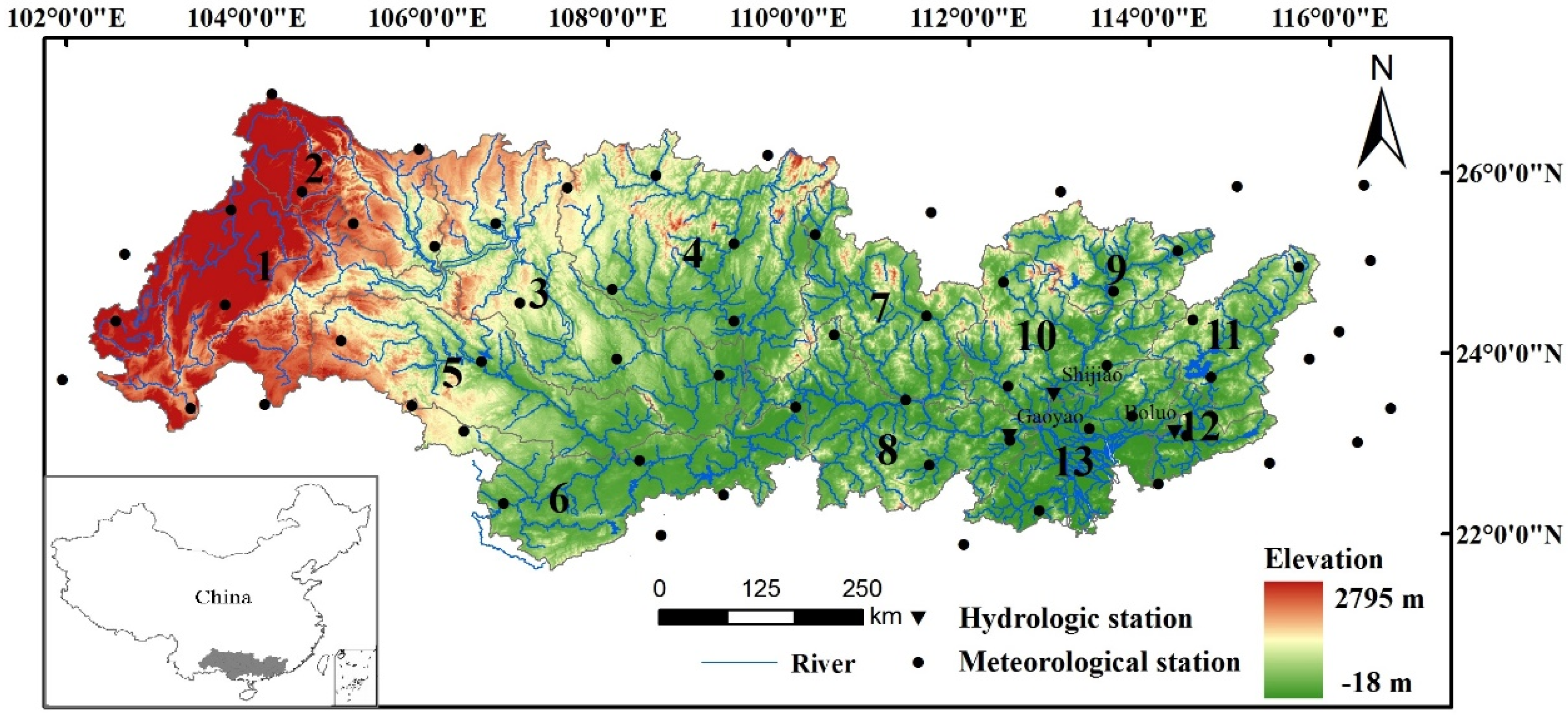
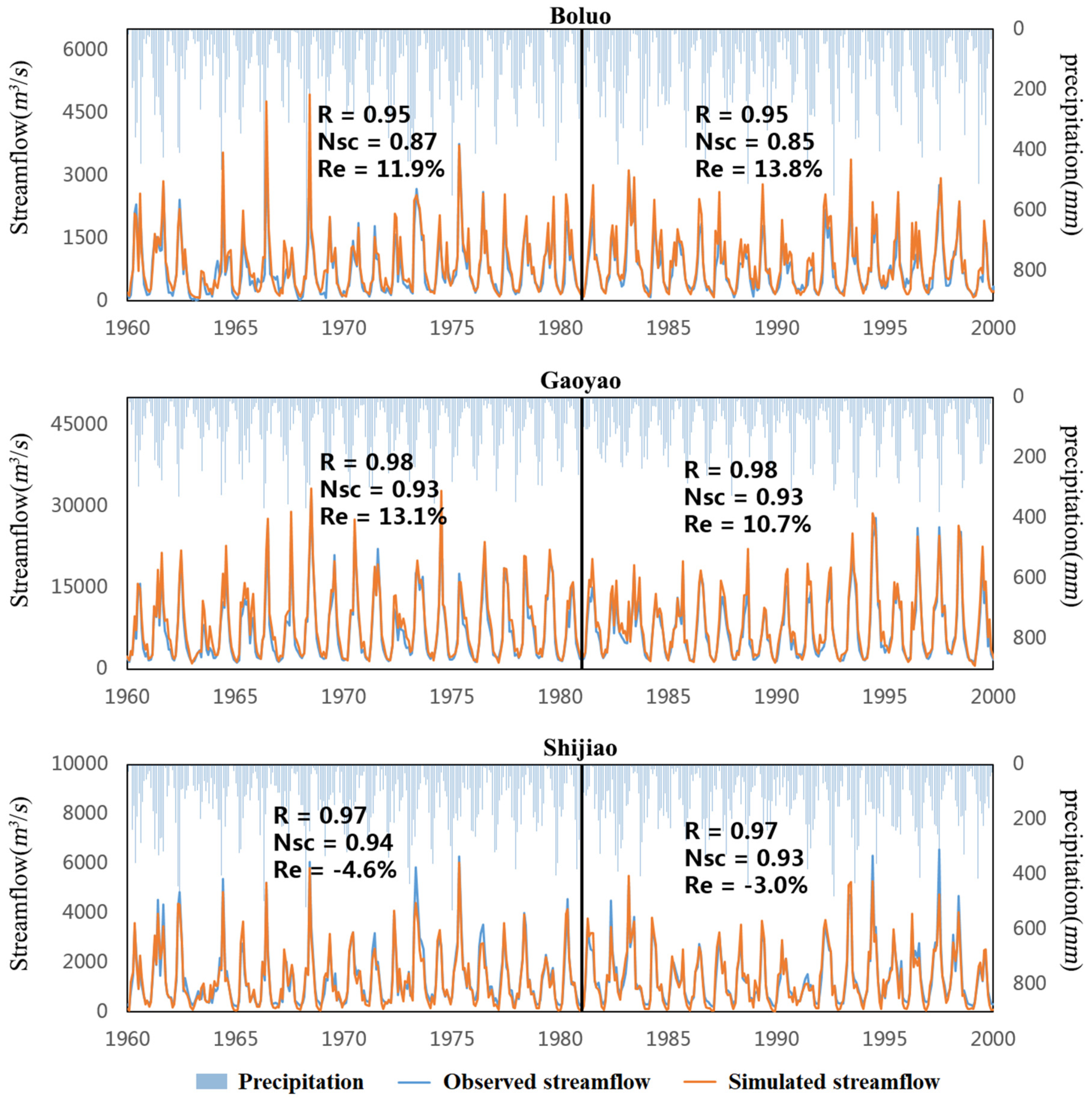
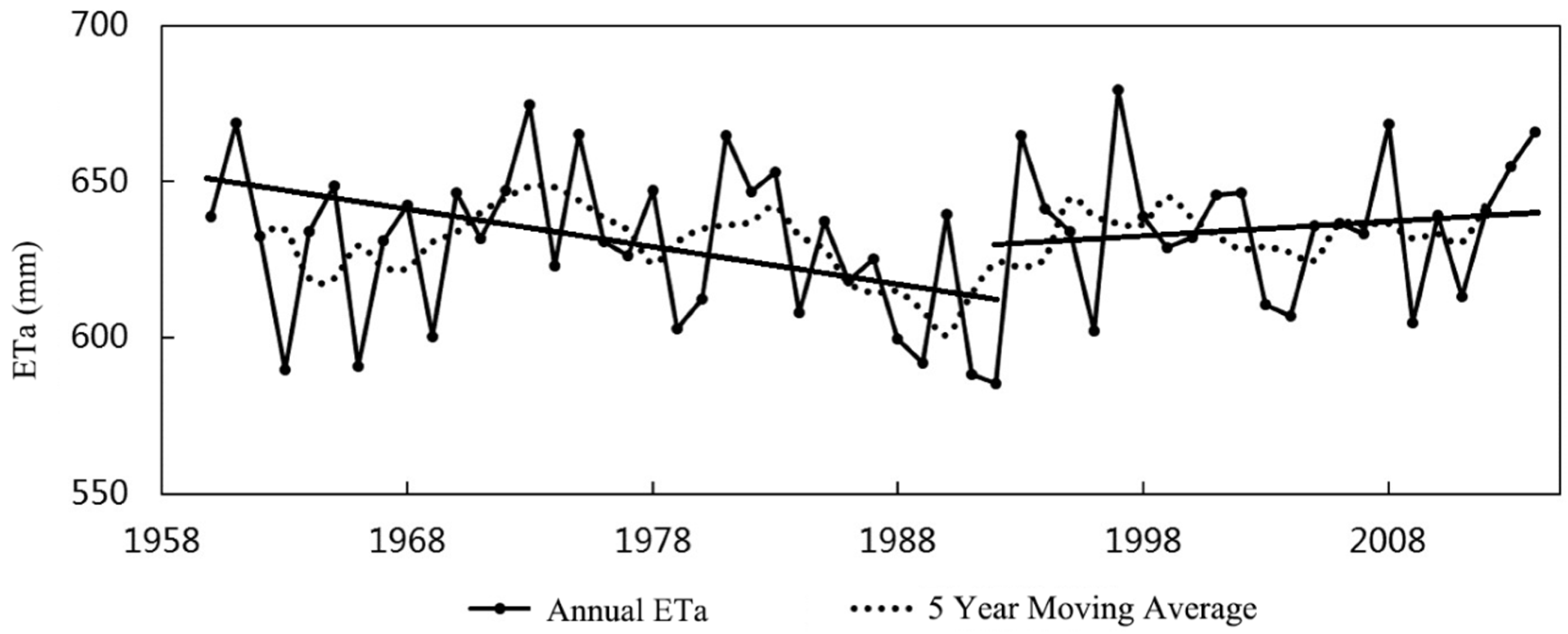
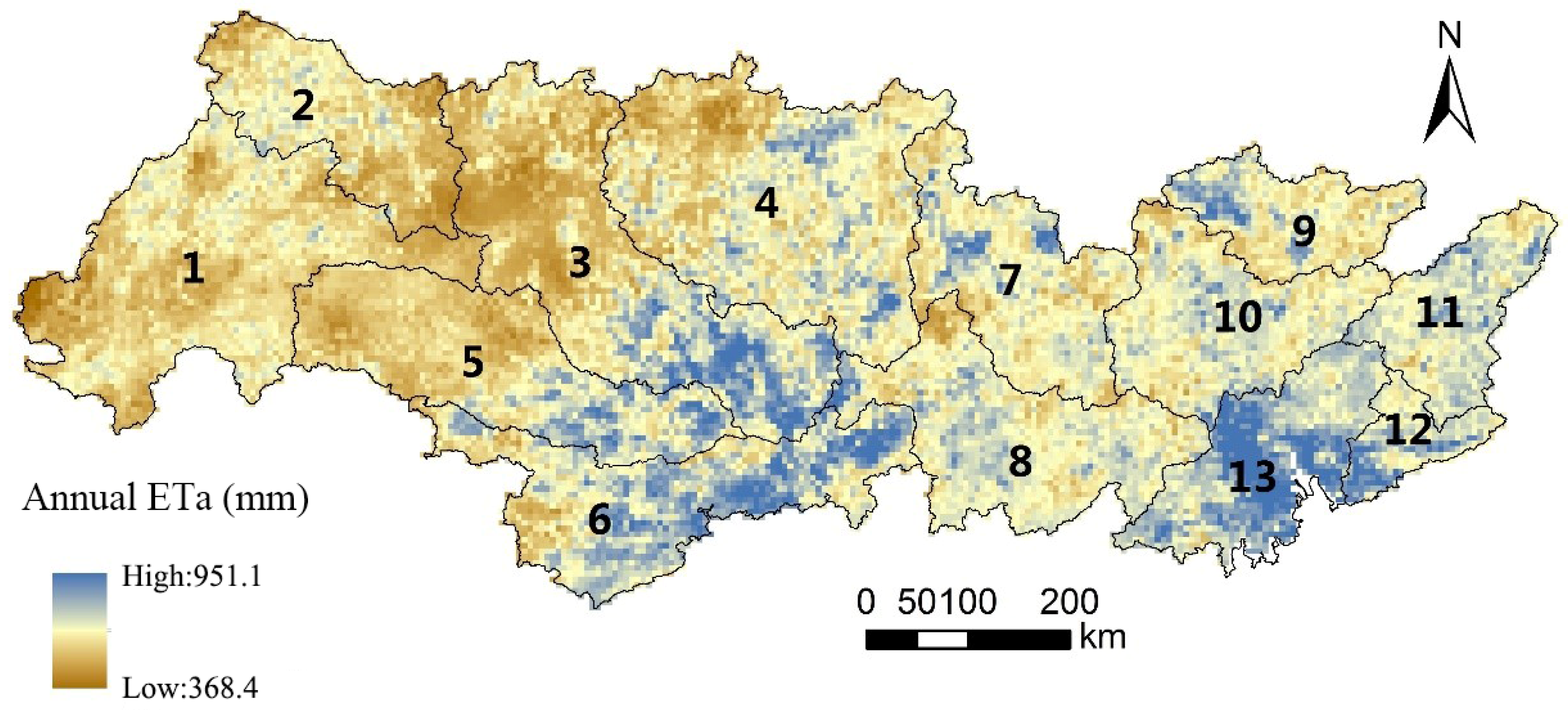
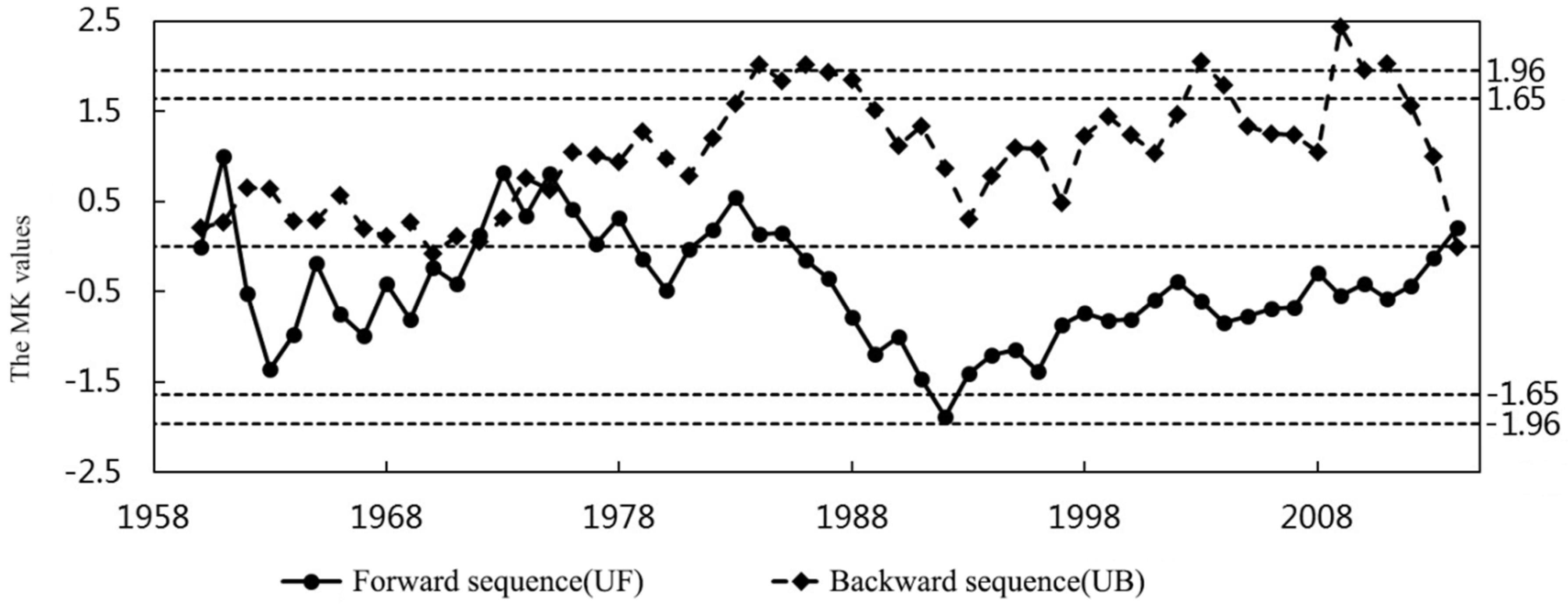
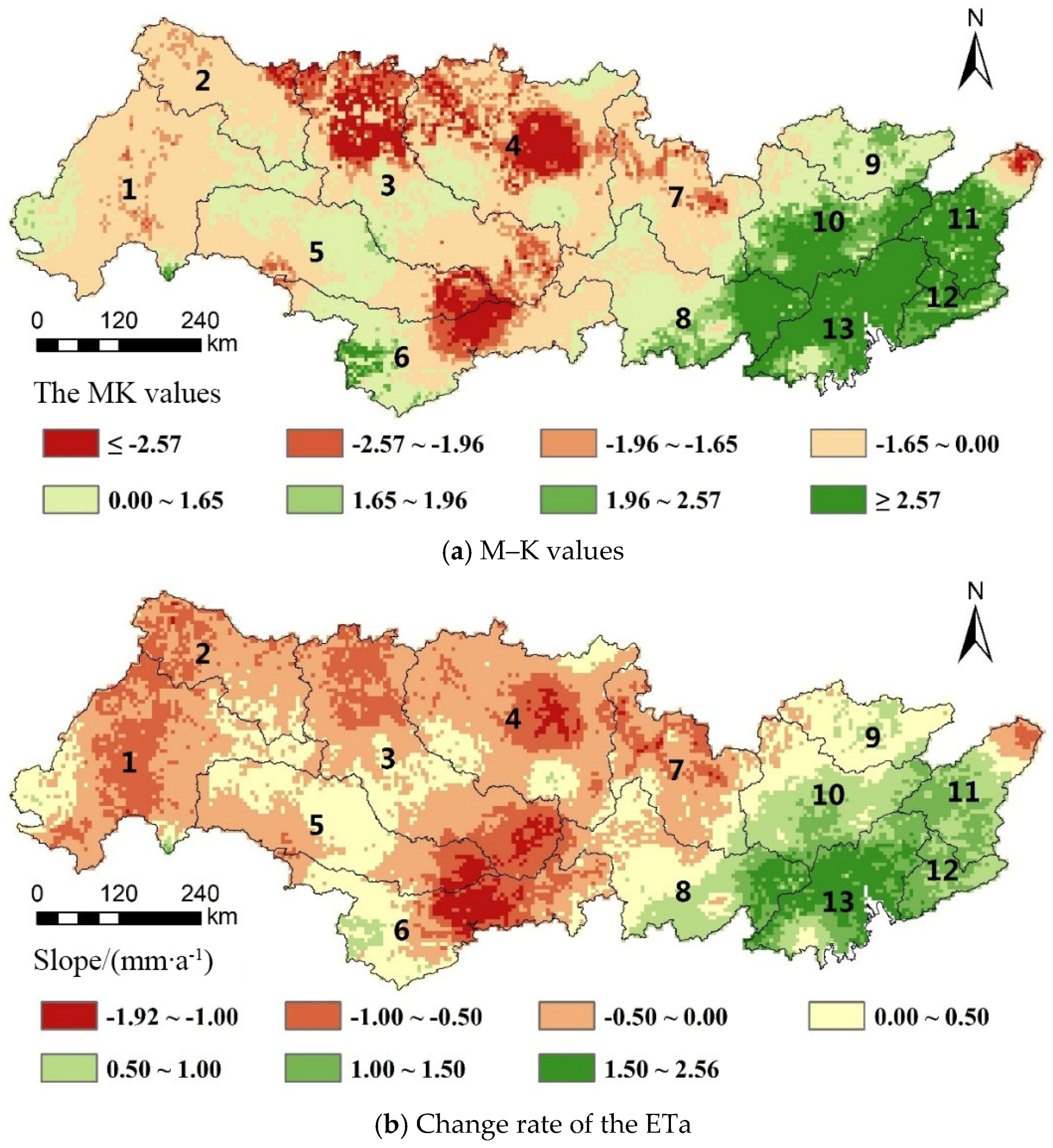
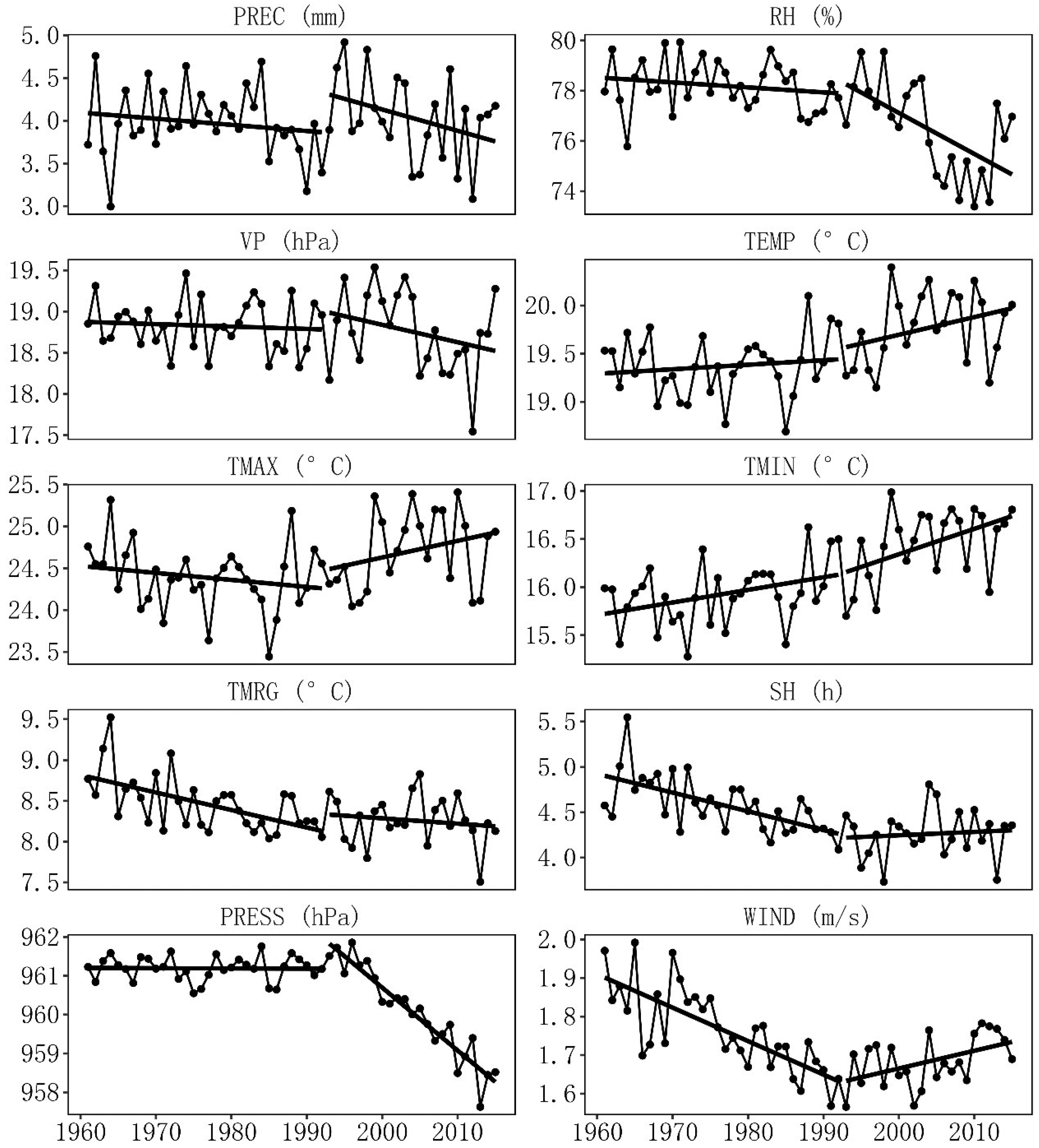
| Data Category | Data Type | Source | Unit |
|---|---|---|---|
| Meteorological | Precipitation | The Chinese Meteorological Administration | mm |
| Max daily air temperature | °C | ||
| Min daily air temperature | °C | ||
| Wind speed | m/s | ||
| Sunshine hours | h | ||
| Shortwave radiation | W/m2 | ||
| Relative humidity | % | ||
| Hydrological | Observed streamflow | Hydrological stations | m3/s |
| Region | January | February | March | April | May | June | July | August | September | October | November | December |
|---|---|---|---|---|---|---|---|---|---|---|---|---|
| 1 | 0.25 | 0.43 | 0.41 | −0.18 | 0.57 | 0.82 | 0.01 | −0.72 | −1.6 | −1.81△ | −1.74△ | −1.95△ |
| 2 | −1.44 | 0.31 | 0.52 | −0.83 | −0.24 | 1.2 | 1.33 | −0.73 | −1.43 | −1.47 | −1.36 | −2.45▲ |
| 3 | −1.6 | 0.85 | 0.7 | −1.87△ | −0.38 | 1.75△ | 0.57 | −1.69△ | −0.91 | −1.63 | −1.71△ | −1.34 |
| 4 | −1.81△ | 0.94 | 0.72 | −1.46 | −0.18 | 3.13★ | 1.4 | −1.1 | −1.55 | −1.28 | −2.19▲ | −1.28 |
| 5 | −1.53 | 0.38 | 0.3 | −0.83 | −0.24 | 2.34▲ | 1.07 | 0.23 | −1.91△ | −2.03▲ | −1.17 | −1.44 |
| 6 | −1.27 | −0.14 | 0.17 | −0.91 | −1.1 | 2.98★ | 2.3▲ | 2.17▲ | −0.86 | −2.05▲ | −1.66△ | −0.56 |
| 7 | −1.71△ | 0.59 | −0.17 | −0.2 | −0.05 | 2.71★ | 1.62 | −1.53 | −1.66△ | −2.19▲ | −1.44 | −0.21 |
| 8 | −0.53 | 0.31 | 1.1 | 0.81 | 1.4 | 3.36★ | 3.33★ | 1.07 | 0.69 | −1.11 | −1.39 | −0.17 |
| 9 | −0.08 | 2.5▲ | 0.49 | 1.31 | 0.73 | 2.93★ | 1.89△ | 0.02 | 0.21 | −2.33▲ | −1.49 | −0.08 |
| 10 | −0.56 | 0.78 | 0.52 | 1.44 | 1.37 | 3.81★ | 2.01▲ | 1.04 | 1.5 | −1.36 | −0.46 | 0.41 |
| 11 | 0.2 | 1.04 | 1.21 | 1.33 | 1.23 | 2.46▲ | 3.3★ | 3.13★ | 2.72★ | −1.39 | −1.02 | 0.28 |
| 12 | 0.47 | 0.63 | 0.68 | 0.59 | 2.46▲ | 3.42★ | 4.28★ | 3★ | 2.81★ | −0.53 | −1.07 | 1.02 |
| 13 | 0.5 | −0.05 | 0.86 | 1.14 | 3.48★ | 4.45★ | 4.07★ | 3.46★ | 3.68★ | −0.97 | −0.69 | 1.2 |
| PRB | −0.86 | 0.66 | 0.88 | −0.52 | 0.82 | 3.87★ | 2.3▲ | 0.34 | −0.79 | −1.89△ | −1.62 | −0.37 |
| Region | Spring | Summer | Autumn | Winter | Year |
|---|---|---|---|---|---|
| 1 | −0.05 | 0.38 | −2.53▲ | −0.16 | −0.94 |
| 2 | −0.24 | 0.24 | −2.42▲ | −0.68 | −0.98 |
| 3 | −0.24 | 0.81 | −2.36▲ | −0.96 | −1.55 |
| 4 | −0.85 | 1.52 | −2.69★ | −1.07 | −1.47 |
| 5 | −0.3 | 2.11▲ | −2.53▲ | −1.14 | −0.54 |
| 6 | −0.72 | 3.72★ | −2.4▲ | −1.32 | −0.76 |
| 7 | −0.04 | 1.04 | −2.55▲ | −0.9 | −0.83 |
| 8 | 2.04▲ | 3.46★ | −1.59 | −0.43 | 1.52 |
| 9 | 1.62 | 2.11▲ | −2.07▲ | 0.74 | 1.33 |
| 10 | 1.84△ | 3.71★ | −1.11 | 0.1 | 2.56▲ |
| 11 | 1.49 | 3.7★ | −0.54 | 0.16 | 2.42▲ |
| 12 | 1.65 | 4.78★ | −0.15 | 0.72 | 3.03★ |
| 13 | 2.42▲ | 5.02★ | −0.08 | 0.89 | 3.58★ |
| PRB | 0.43 | 3.16★ | −2.21▲ | −0.69 | 0.21 |
| 1960~1992 | 1992~2014 | |||||||||||
|---|---|---|---|---|---|---|---|---|---|---|---|---|
| Monthly | Spring | Summer | Autumn | Winter | Yearly | Monthly | Spring | Summer | Autumn | Winter | Yearly | |
| PREC | 0.55★ | 0.66★ | 0.09 | 0.65★ | 0.39▲ | 0.44▲ | 0.48★ | 0.89★ | 0.74★ | 0.80★ | 0.70★ | 0.70★ |
| RH | –0.06 | 0.11 | 0.24 | 0.09 | 0.27 | –0.04 | –0.11△ | 0.42 | –0.36 | 0.05 | 0.23 | 0.24 |
| VP | 0.38★ | 0.05 | –0.14 | 0.15 | 0.05 | 0.53★ | 0.35★ | –0.54▲ | 0.34 | 0.02 | –0.03 | –0.25 |
| TEMP | 0.18★ | –0.16 | –0.02 | –0.20 | –0.03 | –0.47▲ | 0.18★ | –0.60▲ | –0.78★ | –0.15 | 0.08 | –0.59▲ |
| TMAX | 0.05 | 0.34△ | 0.04 | 0.44▲ | 0.27 | –0.06 | 0.06 | 0.00 | 0.76★ | –0.04 | 0.32 | –0.10 |
| TMIN | –0.06 | –0.34△ | –0.04 | –0.44▲ | –0.27 | 0.06 | –0.06 | –0.00 | –0.76★ | 0.04 | –0.32 | 0.10 |
| TMRG | –0.06 | –0.34△ | –0.04 | –0.44▲ | –0.27 | 0.06 | –0.06 | –0.00 | –0.76★ | 0.04 | –0.32 | 0.10 |
| SH | 0.24★ | 0.38△ | 0.14 | 0.49▲ | 0.02 | –0.25 | 0.20★ | 0.83★ | 0.26 | 0.19 | 0.68★ | 0.66★ |
| PRESS | –0.21★ | 0.46▲ | –0.09 | 0.20 | 0.31 | –0.06 | –0.35★ | 0.82★ | 0.17 | 0.14 | 0.18 | 0.48△ |
| WIND | 0.06 | –0.35△ | 0.47▲ | 0.51★ | 0.09 | –0.13 | –0.01 | –0.69★ | 0.28 | –0.11 | 0.21 | 0.05 |
| PREC | RH | VP | TEMP | TMAX | TMIN | TMRG | SH | PRESS | WIND | |
|---|---|---|---|---|---|---|---|---|---|---|
| 1 | 0.62★ | 0.14 | −0.04 | −0.02 | 0.02 | −0.02 | −0.02 | 0.06 | −0.21 | 0.03 |
| 2 | 0.69★ | 0.00 | 0.07 | −0.06 | 0.26△ | −0.26△ | −0.26△ | 0.33▲ | −0.12 | 0.17 |
| 3 | 0.18 | 0.10 | 0.23 | −0.22 | 0.09 | −0.08 | −0.09 | 0.07 | 0.02 | 0.14 |
| 4 | 0.07 | −0.10 | 0.26△ | −0.42★ | 0.14 | −0.13 | −0.13 | −0.16 | 0.14 | 0.15 |
| 5 | 0.35▲ | 0.02 | 0.02 | −0.16 | 0.08 | −0.07 | −0.08 | 0.22 | −0.02 | 0.03 |
| 6 | 0.64★ | −0.28△ | 0.29▲ | −0.24△ | −0.06 | 0.06 | 0.06 | 0.30▲ | −0.13 | 0.12 |
| 7 | 0.45★ | −0.34▲ | 0.38★ | −0.60★ | −0.15 | 0.15 | 0.15 | −0.25△ | 0.08 | 0.62★ |
| 8 | 0.63★ | −0.13 | 0.09 | −0.38★ | −0.04 | 0.04 | 0.04 | −0.07 | −0.02 | 0.40★ |
| 9 | 0.51★ | −0.27△ | 0.27△ | −0.47★ | 0.01 | −0.01 | −0.01 | −0.10 | −0.08 | 0.24 |
| 10 | 0.53★ | −0.31▲ | 0.30▲ | −0.41★ | 0.00 | 0.00 | 0.00 | 0.02 | −0.07 | 0.39★ |
| 11 | 0.48★ | 0.03 | 0.05 | −0.14 | 0.08 | −0.08 | −0.08 | −0.09 | −0.21 | 0.40★ |
| 12 | 0.49★ | 0.25△ | −0.26△ | −0.06 | −0.29▲ | 0.29▲ | 0.29▲ | 0.00 | −0.14 | 0.38★ |
| 13 | 0.69★ | 0.20 | −0.21 | −0.07 | −0.33▲ | 0.33▲ | 0.33▲ | −0.01 | −0.22 | 0.38★ |
© 2019 by the authors. Licensee MDPI, Basel, Switzerland. This article is an open access article distributed under the terms and conditions of the Creative Commons Attribution (CC BY) license (http://creativecommons.org/licenses/by/4.0/).
Share and Cite
Gao, W.; Wang, Z.; Huang, G. Spatiotemporal Variability of Actual Evapotranspiration and the Dominant Climatic Factors in the Pearl River Basin, China. Atmosphere 2019, 10, 340. https://doi.org/10.3390/atmos10060340
Gao W, Wang Z, Huang G. Spatiotemporal Variability of Actual Evapotranspiration and the Dominant Climatic Factors in the Pearl River Basin, China. Atmosphere. 2019; 10(6):340. https://doi.org/10.3390/atmos10060340
Chicago/Turabian StyleGao, Weizhi, Zhaoli Wang, and Guoru Huang. 2019. "Spatiotemporal Variability of Actual Evapotranspiration and the Dominant Climatic Factors in the Pearl River Basin, China" Atmosphere 10, no. 6: 340. https://doi.org/10.3390/atmos10060340
APA StyleGao, W., Wang, Z., & Huang, G. (2019). Spatiotemporal Variability of Actual Evapotranspiration and the Dominant Climatic Factors in the Pearl River Basin, China. Atmosphere, 10(6), 340. https://doi.org/10.3390/atmos10060340






